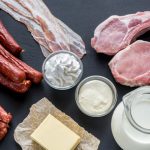Fat crystallization is a complex phenomenon that plays a crucial role in various industries, especially in food processing, cosmetics, and pharmaceuticals. This process involves the transformation of fats from a liquid or amorphous state into a structured crystalline form. The crystallization of fats significantly influences the texture, stability, mouthfeel, and overall quality of products such as chocolate, margarine, and butter. Understanding fat crystallization requires exploring the molecular structure of fats, the conditions that influence crystallization, and the techniques used to control and measure this process.
Molecular Structure of Fats
Fats, or triglycerides, are composed of glycerol molecules esterified with three fatty acid chains. These fatty acids can vary in length and degree of saturation. Saturated fats have no double bonds between carbon atoms, leading to straight chains that pack closely together, while unsaturated fats contain one or more double bonds, introducing kinks in the chains and hindering tight packing.
Phases of Fat Crystallization
The general situation for fats to crystallize is first to see nucleation and growth of crystals, followed by their aggregation due to van der Waals attraction ending up with the formation of a crystalline 3D-network (Walstra et al., 2001).
- Nucleation: The initial stage of crystallization where small clusters of fat molecules (nuclei) form. Nucleation can be homogeneous, occurring spontaneously throughout the liquid, or heterogeneous, occurring on impurities or surfaces.
- Crystal Growth: Once nuclei form, additional fat molecules attach to these clusters, allowing the crystals to grow. We now see the start of a crystalline 3D network forming. This is the aggregation phase of growth and occurs because of van der Waals attraction The rate of crystal growth depends on factors like temperature, the degree of supercooling, and the presence of other components in the fat mixture.
- Maturation: During this phase, crystals can undergo transformations, such as polymorphic transitions where they rearrange into more stable forms. Polymorphism is a characteristic feature of fats, where the same chemical composition can exist in different crystal structures (e.g., α, β’, and β forms). A number of different polymorphs can exist within the same sample. It is widely accepted that some of the different properties of fats in a system are down to these collections of crystal polymorphs.
Factors Influencing Fat Crystallization
- Temperature: Cooling rate significantly impacts crystallization. Rapid cooling favors the formation of less stable polymorphs (e.g., α form), while slow cooling allows for more stable polymorphs (e.g., β form) to develop. The melting and crystallization temperatures vary depending on the fatty acid composition.
- Composition: The type and proportion of fatty acids in a fat mixture affect its crystallization behavior. Saturated fats tend to crystallize more readily than unsaturated fats. Additionally, the presence of minor components, such as emulsifiers, can influence nucleation and crystal growth.
- Shear and Mixing: Mechanical agitation during cooling can promote nucleation and influence the size and shape of fat crystals. This is particularly relevant in industrial processes where consistency and texture are critical.
- Additives: Ingredients such as emulsifiers, surfactants, and other lipids can modify crystallization. Emulsifiers, for instance, can inhibit or promote specific polymorphic forms, altering the texture and stability of the final product.
Measurement and Control of Fat Crystallization
- Differential Scanning Calorimetry (DSC): DSC measures the heat flow associated with melting and crystallization, providing information on transition temperatures and enthalpies. It helps identify polymorphic forms and assess the stability of fat crystals.
- X-Ray Diffraction (XRD): XRD is used to determine the crystalline structure of fats. It helps identify different polymorphic forms and monitor changes during processing and storage.
- Polarized Light Microscopy (PLM): PLM allows for the visualization of fat crystals, providing insights into their size, shape, and distribution. This technique is useful for studying nucleation and growth dynamics.
- Rheology: Rheological measurements assess the flow and deformation behavior of fat systems. They provide information on how crystallization affects the mechanical properties of fats, such as hardness and spreadability.
Fat Mixtures
In most applications, fat is derived from plants or vegetal fats and from animals. Some sources include algae, bacteria and yeasts but most commonly it is plant. These fats are usually mixtures of many different types of triglycerides. Because of the variability in fat composition they all behave differently in terms of their physical properties. Crystallization is no different!
Crystallization of the vegetable derived fats have been studied extensively:-
- palm oil (Berger & Wright, 1976; Jacobsberg & Ho., 1976)
Palm oil is one of the best characterised fats in the industry because it is so commonly used in various applications.
Applications in Food Industry
- Chocolate: The quality of chocolate is heavily dependent on the crystallization of cocoa butter. Proper tempering is crucial to ensure the formation of the stable β-V polymorph, which gives chocolate its desirable snap, gloss, and smooth mouthfeel.
- Margarine and Spreads: The consistency of margarine and spreads is influenced by the crystallization of fat blends. The goal is to achieve a product that is spreadable at refrigeration temperatures but firm at room temperature.
- Bakery Products: The texture and shelf-life of baked goods like pastries and cakes are affected by the crystallization behavior of fats. Proper control ensures desirable flakiness and mouthfeel.
Challenges and Advances
Controlling fat crystallization is challenging due to the complex nature of fats and their interactions with other ingredients. Advances in analytical techniques and a deeper understanding of fat crystallization mechanisms have led to improved control over texture and stability in food products.
Innovations in formulation, such as the use of structured lipids and interesterified fats, have provided new ways to manipulate crystallization behavior. Structured lipids are designed to have specific fatty acid compositions, offering tailored melting and crystallization properties. Interesterification alters the position of fatty acids on the glycerol backbone, modifying crystallization characteristics.
Future Directions
Future research in fat crystallization is likely to focus on the development of healthier fat alternatives that mimic the functional properties of traditional fats while offering nutritional benefits. This includes the use of novel fat substitutes, such as oleogels and emulsions, which can provide similar textural properties with reduced saturated fat content.
Additionally, the application of advanced imaging techniques, such as atomic force microscopy (AFM) and synchrotron radiation, will enhance the understanding of fat crystallization at the nanoscale. These insights can lead to more precise control over crystallization processes and the development of novel fat-based products.
Fat crystallization is a vital process that influences the quality and functionality of many products in the food industry and beyond. By understanding the molecular mechanisms and factors affecting crystallization, and utilizing advanced analytical techniques, manufacturers can optimize product properties to meet consumer demands and enhance the sensory and nutritional qualities of their offerings.
References
, . (1976). Crystallisation behaviour of palm oil. Paper presented at ISF conference, September 1976, Marseille , France.
, . (1976). Studies in palm oil crystallisation. J Am Oil Chem Soc. 53: pp. 609–17
, , . (2001). Fat crystals networks. In: K Sato, N Garti, editors. Crystallization processes in fats and lipid systems. CRC Press. New York : Marcel Dekker, pp. 289–328.


Leave a Reply